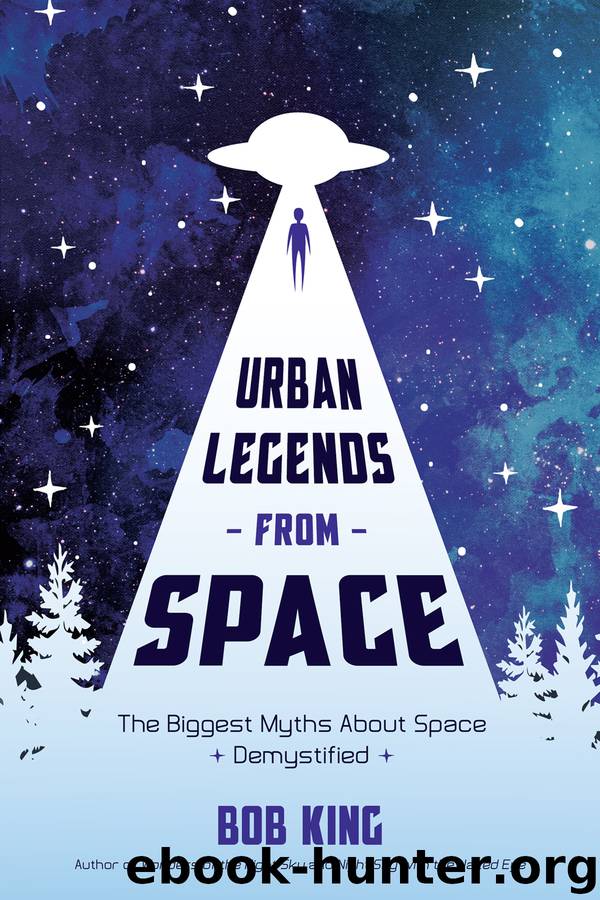Urban Legends from Space by Bob King

Author:Bob King
Language: eng
Format: epub
Publisher: Page Street Publishing
Published: 2019-12-29T16:00:00+00:00
The twin tidal bulges are not caused by centrifugal force but by the moon’s gravity. Even if the Earth stopped spinning the bulges would remain. The moon puts a squeeze on the Earth akin to squeezing a round balloon until the sides bulge out. (Bob King)
The overall effect of the tidal force is to stretch an object. Because water is free to move, we get bulges, but the solid body of the Earth flexes, too, rising and settling about 1 foot (30 cm) a day.
When a location on Earth passes through a bulge, it experiences a high tide. Two bulges mean two high tides each day separated by two low tides between the bulges. The time from one moonrise to the next is about 25 hours, so high tides occur about once every 12½ hours. Water rises at a beach during high tide, and then drops to a low 6 hours later at low tide. Six hours after that the next high tide sweeps in, followed by the next low tide. This happens every day no matter the phase of the moon. As described earlier, the sun also plays an important though lesser role in tide making.
In the open ocean, the tidal force of the moon raises water about 3 feet (1 m), but that height varies a lot at any particular location depending on the angle and depth of the seabed, the shape of a beach and the strength of the prevailing winds. Because the moon’s distance from the Earth varies around its orbit, its pulling power does, too. When closest, it raises the tides even higher. If that time coincides with a full moon, when the sun’s share kicks in, then locations experience extra-high tides called perigean tides. If you want to experience the highest tides on Earth, head to the Bay of Fundy in Nova Scotia, where under the right conditions the water can rise up to 53 feet (16 m)!
Tidal forces between the Earth and the moon are responsible for both the slowing down of Earth’s rotation and the fact that we only see one face of the moon. Earth’s faster rotation carries the moon-facing bulge a little ahead of the Earth–moon line. The hump has mass and therefore gravity and pulls the moon forward in its orbit. At the same time, the moon’s gravity pulls back on the hump in a sort of gravitational tug-of-war. The friction generated between the water and the solid Earth gradually slows the Earth’s rotation.
Tidal friction is the reason the International Earth Rotation and Reference Systems Service has to add a leap second to the day every so often to take into account Earth’s slowing rotation. In a hundred years the day will be 2 milliseconds longer. Based on studies of shoreline sediments called rhythmites, 620 million years ago a day on Earth lasted about 22 hours. In the distant future our descendants will experience longer days and hopefully more free time.
Meanwhile, the energy that Earth loses through tidal friction
Download
This site does not store any files on its server. We only index and link to content provided by other sites. Please contact the content providers to delete copyright contents if any and email us, we'll remove relevant links or contents immediately.
| Aeronautics & Astronautics | Astronomy |
| Astrophysics & Space Science | Comets, Meteors & Asteroids |
| Cosmology | Mars |
| Solar System | Star-Gazing |
| Telescopes | UFOs |
Tools of Titans by Timothy Ferriss(8218)
Turbulence by E. J. Noyes(7936)
Secrets of Antigravity Propulsion: Tesla, UFOs, and Classified Aerospace Technology by Ph.D. Paul A. Laviolette(5309)
Astrophysics for People in a Hurry by Neil DeGrasse Tyson(5132)
Room 212 by Kate Stewart(5037)
Design of Trajectory Optimization Approach for Space Maneuver Vehicle Skip Entry Problems by Runqi Chai & Al Savvaris & Antonios Tsourdos & Senchun Chai(5011)
Pale Blue Dot by Carl Sagan(4912)
The David Icke Guide to the Global Conspiracy (and how to end it) by David Icke(4625)
A Journey Through Divination and Astronomy by Publishing Pottermore(4344)
Goodbye Paradise(3727)
Apollo 8 by Jeffrey Kluger(3637)
COSMOS by Carl Sagan(3554)
Losing the Nobel Prize by Brian Keating(3498)
The Five People You Meet in Heaven by Mitch Albom(3475)
How to Read Water: Clues and Patterns from Puddles to the Sea (Natural Navigation) by Tristan Gooley(3406)
Brief Answers to the Big Questions by Stephen Hawking(3369)
How to Read Nature by Tristan Gooley(3249)
The Order of Time by Carlo Rovelli(3145)
A Brief History of Time by Stephen Hawking(2960)
